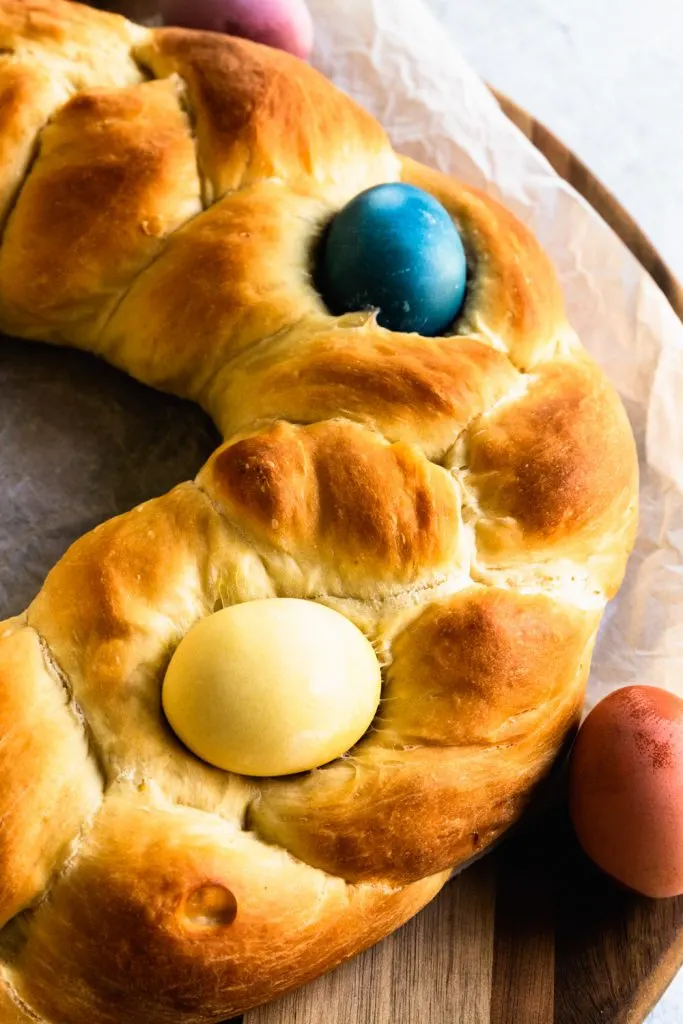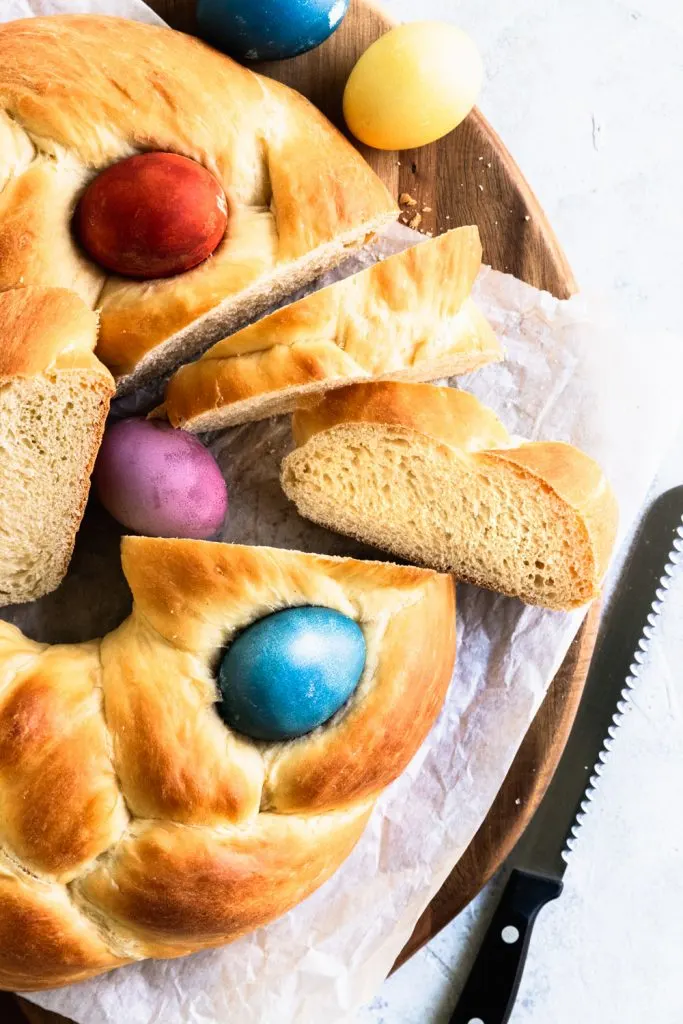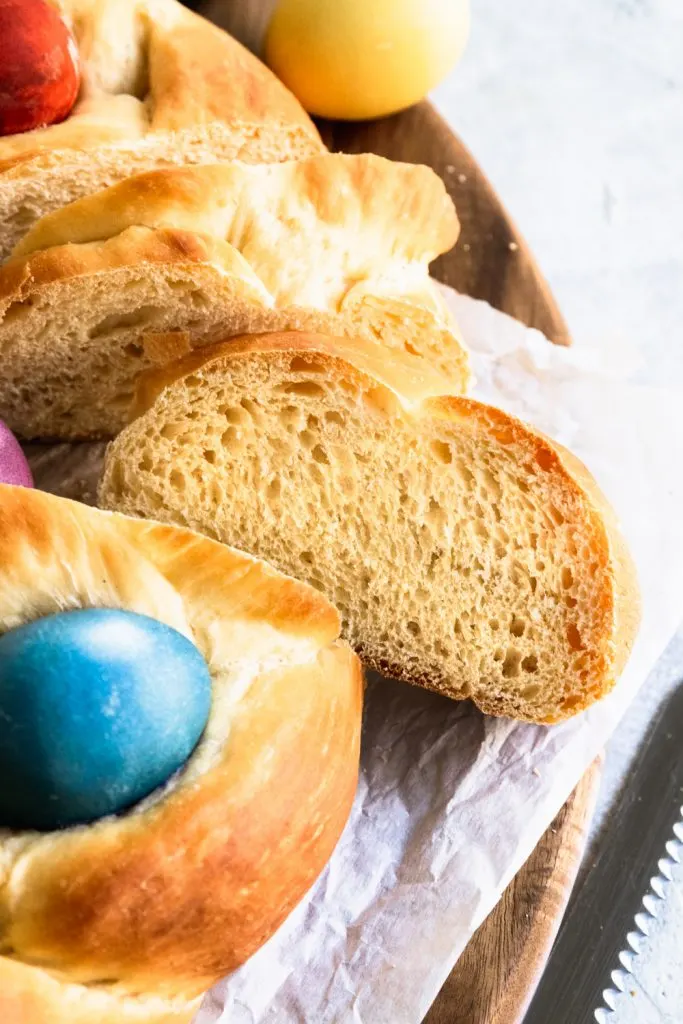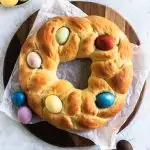Italian Easter Bread (also called Pane di Pasqua) is a tender, slightly sweet loaf with colorful Easter eggs pressed into the top for a stunning centerpiece loaf of bread.

What is Pane di Pasqua?
Pane di Pasqua, also known as Italian Easter Bread, is a sweet, enriched bread that is braided or twisted and then turned into a circle, giving you an impressive crown shaped loaf. Dyed Easter eggs, which represent new life coming from the egg shell just as Jesus rose from the tomb, are then pressed into the loaf. The result is a beautiful, colorful loaf for your Easter feast.
Optional Flavors and Additions
- Some traditional Italian recipes call for the addition of 1/2 tsp. of anise seed to the bread dough.
- You can add brightly colored jimmie sprinkles to the top of the loaf before baking to make it extra bright and colorful.
- If you would prefer an orange flavored loaf, you can substitute orange zest for the lemon.
Save it on Pinterest:

How to Make Italian Easter Bread
Warm the milk slightly and place it with the sugar in the bowl of a stand mixer and sprinkle the yeast over the top. Allow the yeast to sit for about 5 minutes, or until it’s foamy.
Once the yeast has foamed, add the beaten eggs and lemon zest and stir them in, using the dough hook attachment for your mixer.
Add the flour and salt to the mixer and stir until combined. With the mixer still running on medium low speed, add the softened butter in small chunks, allowing each one to be incorporated into the dough before adding more.
Once all of the butter is in the dough, turn the mixer speed up to medium and beat it for 4-5 minutes, or until it is a smooth ball of dough on the hook. It will be a fairly loose dough, so will fall back off the hook once the mixer has stopped.
Cover the dough with plastic wrap and set it aside to rise in a warm area for 2-3 hours.

How to Braid and Decorate the Bread
Begin by dividing your loaf into three equal sections (a scale helps make them the same size). Next, roll each section of the dough into a 24″ long rope. Try to keep it as even as possible while rolling.
Lay the three sections of bread dough next to each other and press the ends together. Bring the right piece of dough over the center piece. Then bring the left piece over the center (which was originally the rope on the right). Continue this pattern, alternating the dough ropes on the left and right going over the center one, until you’ve reached the end of the dough.
Next, bring around the ends of the braid to meet, creating a circle with them. Tuck the ends in together to continue the braided look, pinching any ends to prevent them from splitting apart.
Carefully lift the braided bread crown onto a large parchment-lined baking sheet. Beat an egg until smooth then use a pastry brush to brush the egg wash over the entire loaf.
Gently press uncooked, dyed Easter eggs onto the top of the loaf.

Baking the Italian Easter Bread
When the bread is close to finishing rising, preheat the oven to 350°F. Place an oven rack in the center of the oven.
Beat an egg until smooth then use a pastry brush to brush the egg wash over the entire loaf, avoiding wetting the easter eggs.
Bake the loaf for 30-35 minutes, or until the outside is golden brown. Remove it from the oven and allow it to cool for about an hour before slicing.
Tips for Pressing the Easter Eggs onto the Bread:
Place the eggs in the very center of the braid or slightly towards the center. This insures that they don’t roll off when the bread is rising and baking.
Odd numbers are generally the most visually pleasing, and I recommend about 5 eggs for this size of loaf.
While most colored Easter eggs are hard-boiled, uncooked eggshells dye just as well. If you press uncooked eggs into the top of the Italian Easter bread, they’ll be a perfect hard-boiled egg consistency after baking in the loaf for 25-30 minutes.

Making Small Easter Breads
Divide the dough into 8 equal sections, then roll each into an 8″ rope. Twist two of the ropes together, then bring the ends together and pinch them to create a circle. There’s shouldn’t be much of a hole in the center. Repeat this with the other dough sections until you have 4 miniature Italian Easter bread loaves.
Brush each of them with egg wash and place a dyed Easter egg in the center of each loaf. Allow the miniature loaves to rise until doubled in size (this should take about 1-2 hours), then bake at 350° for about 20 minutes, or until the loaves are all golden brown.


Italian Easter Bread {Pane di Pasqua}
Description
Italian Easter Bread (also called Pane di Pasqua) is a tender, slightly sweet loaf with colorful Easter eggs pressed into the top for a stunning centerpiece loaf of bread.
Ingredients
- 1/2 cup white sugar
- Zest of lemon
- 5 cups (700 g) all-purpose flour
- 2 tsp. salt
- 1 cup (8 oz.) whole milk
- 1 pkg. (2 1/4 tsp./7 g) yeast
- 4 large eggs
- 8 Tbsp. (114 g) very soft butter
- 5 raw eggs, dyed
Instructions
How to Make Italian Easter Bread
Warm the milk slightly and place it with the sugar in the bowl of a stand mixer and sprinkle the yeast over the top. Allow the yeast to sit for about 5 minutes, or until it’s foamy.
Once the yeast has foamed, add the beaten eggs and lemon zest and stir them in, using the dough hook attachment for your mixer.
Add the flour and salt to the mixer and stir until combined. With the mixer still running on medium low speed, add the softened butter in small chunks, allowing each one to be incorporated into the dough before adding more.
Once all of the butter is in the dough, turn the mixer speed up to medium and beat it for 4-5 minutes, or until it is a smooth ball of dough on the hook. It will be a fairly loose dough, so will fall back off the hook once the mixer has stopped.
Cover the dough with plastic wrap and set it aside to rise in a warm area for 2-3 hours.
How to Braid and Decorate the Bread
Begin by dividing your loaf into three equal sections (a scale helps make them the same size). Next, roll each section of the dough into a 24″ long rope. Try to keep it as even as possible while rolling.
Lay the three sections of bread dough next to each other and press the ends together. Bring the right piece of dough over the center piece. Then bring the left piece over the center (which was originally the rope on the right). Continue this pattern, alternating the dough ropes on the left and right going over the center one, until you’ve reached the end of the dough.
Next, bring around the ends of the braid to meet, creating a circle with them. Tuck the ends in together to continue the braided look, pinching any ends to prevent them from splitting apart.
Carefully lift the braided bread crown onto a large parchment-lined baking sheet. Gently press uncooked, dyed Easter eggs onto the top of the loaf.
Place the loaf inside a large, clean bag and allow it to rise for another 1-2 hours. It won’t double in size, but will look puffy. When you press a finger into the loaf, the indentation you leave you come back slowly.
Baking the Italian Easter Bread
When the bread is close to finishing rising, preheat the oven to 350°F. Place an oven rack in the center of the oven.
Beat an egg until smooth then use a pastry brush to brush the egg wash over the entire loaf, avoiding wetting the easter eggs.
Bake the loaf for 30-35 minutes, or until the outside is golden brown. Remove it from the oven and allow it to cool for about an hour before slicing.
